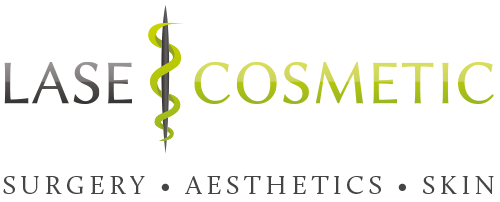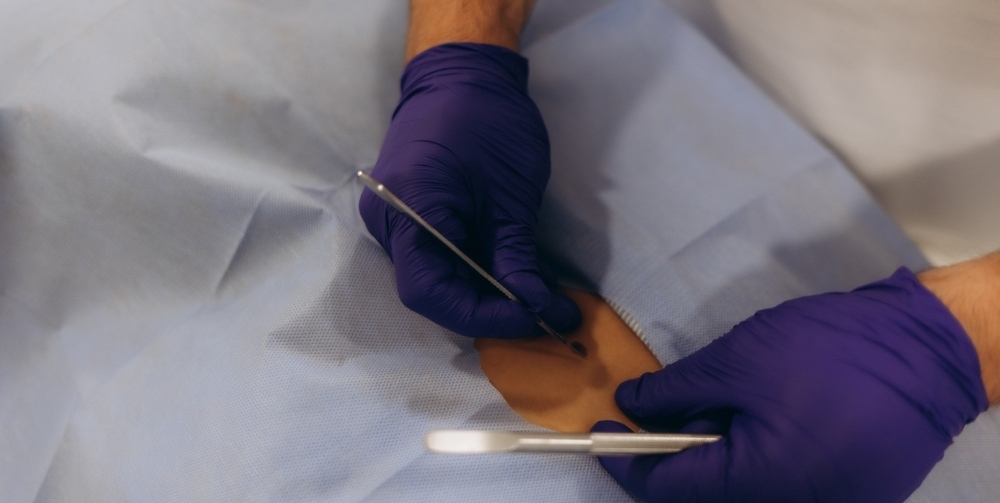Skin lesion removal is a straightforward procedure that involves removing a mole, skin tag, wart, or other skin growth.
Patients are usually in and out of the clinic in 1 hour with minimal downtime. This, of course, depends on the type of skin lesion being removed and the removal method, both of which are discussed during a consultation.
There’s lots of reasons why people have a skin lesion removal, whether that’s by choice or as recommended by a doctor if they think it could become cancerous.
In this blog, we’ll be discussing:
- Different types of skin lesions
- When you should consider skin lesion removal
- Skin lesion removal treatments
- Recovery and aftercare
- Skin lesion removal FAQs
With over 40 years of combined experience in the aesthetic industry, we provide you with all the information you need to make the right treatment choice. When it comes to skin lesions, all of our consultant plastic surgeons are skin cancer experts, and we will assess your lesion using a dermatoscope (a visual aid used when examining and diagnosing lesions). We also have pathology diagnostic services available so your lesion can be tested for anything of concern.
Let’s start this guide by looking at the different types of skin lesions you might have.
Different Types of Skin Lesions
Knowing the different types of skin lesions helps you identify if you have any of these on your own body so you can get them checked.
It’s important to highlight that there are two different types of skin lesions – benign (non-cancerous) and malignant (cancerous).
Many non-cancerous growths look similar to cancerous growths so often doctors will recommend having them removed just to be on the safe side.
- Moles – These are small, dark-coloured skin growths
- Warts – These are small, rough lumps caused by HPV infection
- Dermatofibroma – These are firm growths that are brown, purple or red in colour. They can develop after an insect bite or minor injury
- Actinic keratosis – These are rough in texture and develop on areas exposed to the sun
- Seborrhoeic keratosis – These are grey, black or brown in colour and often raised. You’ll usually find them on your body or scalp and they’re more common with age
- Sebaceous cysts – These are round lumps that can become infected and range in size from a few millimetres to several centimetres
- Keratoacanthoma – These grow rapidly and have a solid, scaly core. You’ll’ often get them on areas exposed to the sun such as your face
- Skin tags – Skin tags are very common, flesh-coloured growths forming where skin creases or rubs
- Pyogenic granuloma – These are bright red nodules that are often small in size. They can develop after an injury and bleed easily
Note: If you notice any changes to any skin growth, such as a change in colour, texture, or size, get it checked by your GP.
When to Get Skin Lesion Removal
There are lots of reasons why people get skin lesions removed, from being self-conscious about the way it looks to having a genuine concern about it becoming cancerous.
In terms of cosmetic reasons, you might find that it’s catching on your clothing or you might feel uncomfortable when wearing certain things.
In both of these cases, you will probably have to pay for the skin lesion removal as they are deemed as being cosmetic concerns i.e. the skin lesion isn’t causing any harm.
However, if there’s a chance the skin lesion could become cancerous you would be given the option for pathology as it would then be considered a medical necessity.
Skin lesion removal usually leaves a scar, however this depends on how much skin is being removed and the type of removal – something we’re discussing in more detail below.

Need Help Deciding Which Treatment Is Right For You?
Book your consultation with our experts here.
Skin Lesion Removal Treatments
The type of skin lesion removal depends on what skin lesion you have and where it is on your body. There are various ways you can have it removed, all of which will be discussed during a consultation.
At LASE Cosmetic, we carry out a thorough one-to-one assessment before any treatment and explain what to expect before, during, and after. Skin lesion removal is performed as a non-surgical or minor surgical procedure at our Newcastle clinic. If needed, the lesion can be sent for pathology.
Excision
Excision involves cutting out the entire skin lesion, using a scalpel. It’s typically done under local anaesthetic. This method is commonly used when a skin lesion is suspicious or confirmed as cancerous or when a complete removal is necessary for diagnosis or peace of mind.
The area surrounding the open wound is then closed with sutures..
Partial removal (shave biopsy)
This removal method involves shaving off the skin lesion either at or just below skin level using a blade. It’s most commonly used for raised, superficial lesions like moles or seborrheic keratoses or in situations where a full-thickness sample isn’t required.
It’s quicker and less invasive than excision and doesn’t usually require stitches. However, it can still leave a scar.
Cauterisation
This uses heat from an electrically heated probe to burn and destroy abnormal skin tissue. It’s often used for small lesions such as warts, skin tags, or seborrheic keratoses. It can also help stop bleeding after other skin lesion removal techniques, like curettage.
Laser therapy
This technique uses concentrated light energy to target and destroy skin lesions without damaging surrounding tissue. It’s most effective for growths, warts, and skin tags. It offers precision and minimal downtime. At LASE Cosmetic, we use Asclepion Cool Laser which is a Erbium YAG laser used for skin ablation and fractional therapy. We can effectively remove skin lesions quickly and painlessly with very little downtime in our-one stop lesion removal clinic.
Freezing (cryotherapy)
This technique involves applying liquid nitrogen to freeze and destroy abnormal skin cells. It’s a quick and effective treatment for warts, actinic keratoses, and some benign lesions. The frozen tissue eventually falls off as the skin heals.
In some cases, multiple sessions may be needed for thicker lesions.
Curettage
This uses a spoon-shaped instrument (a curette) to scrape away a skin lesion. It’s often combined with cauterisation to destroy any remaining abnormal tissue and to prevent bleeding.
This technique is most commonly used for benign growths such as seborrheic keratoses and some superficial skin cancers.
Photodynamic therapy (PDT)
This skin lesion removal technique involves applying a light-sensitive cream to the lesion, allowing it to absorb, and then exposing it to a particular wavelength of light.
In turn, this activates the cream which destroys abnormal cells. It’s commonly used for actinic keratoses and superficial skin cancers. PDT is non-invasive and can be repeated if needed.
Drainage
Drainage is most commonly used for infected or fluid-filled lesions, such as abscesses or cysts. A small incision is made to release pus or fluid, relieving pressure and reducing the infection.
This is then followed by wound care and possibly antibiotics.
Creams and gels
These are topical treatments applied directly to the lesion, usually prescribed for superficial skin conditions. Common options are:
Imiquimod – This stimulates the immune system to fight abnormal cells (used for actinic keratoses, superficial basal cell carcinoma).
5-Fluorouracil (5-FU) – A topical chemotherapy agent that destroys abnormal skin cells.
Creams are typically used over several weeks and work best for flat skin lesions.
Skin Lesion Removal Before & After
To give you an idea of the kind of results that can be achieved with skin lesion removal, see before and after photos of the treatment below. Please note, results differ depending on the individual.

Skin Lesion Removal and Aftercare
The consultant or nurse consultant will advise you on how to care for your wound, and you may have a follow up appointment to remove any stitches depending on the type of skin lesion removal method used.
Whilst you will get specific advice relating to your own treatment, general aftercare advice includes:
- Avoid touching or scratching the area, particularly if stitches have been used.
- Keep the wound dry for the first 24 to 48 hours, or until advised otherwise. After that, gently clean the area daily with mild soap and water, and pat dry.
- Be careful not to pick scabs or make any attempt to remove them. Let them fall off naturally to help minimise scarring.
- Avoid strenuous activity or stretching the area, particularly if stitches are present or the wound is in a high-movement area.
- Protect the area from sun exposure. Once the wound is healed, use SPF to help prevent darkening of the scar (post-inflammatory pigmentation).
Note: Keep an eye on any signs of infection such as swelling, redness, or pus. Contact the clinic if you’re concerned.
Skin Lesion Removal FAQs
Does skin lesion removal hurt?
Direct excision, shave excision, and laser removal are performed under local anaesthetic, which is administered using a fine needle to minimise any discomfort. Once the anaesthetic takes effect, you shouldn’t feel any pain during the procedure. Cryotherapy usually doesn’t require local anaesthetic, as any mild discomfort is brief and well-tolerated.
What are the risks associated with skin lesion removal?
Potential risks include infection, bleeding, pain, scarring at the treatment site (including the possibility of thick or raised keloid scars), incomplete removal, recurrence of the lesion, changes in skin contour, and changes in skin colour such as lightning (hypopigmentation) or darkening (hyperpigmentation).
Skin Lesion Removal: What It Involves & When to Consider It
Skin lesion removal is a straightforward procedure that removes skin lesions including skin tags, moles, cysts and lipomas. Whilst they are often removed for aesthetic reasons, people can have genuine concerns and they may need to be assessed by one of our consultant surgeons.
At LASE, all of our consultant plastic surgeons are skin cancer experts and can assess your lesion to check its condition.
The best way to get started is through a one-to-one consultation allowing us to best assess your needs. Simply get in touch with our team – we look forward to welcoming you to our clinic.

Need Help Deciding Which Treatment Is Right For You?
Book your consultation with our experts here.


Recent Comments